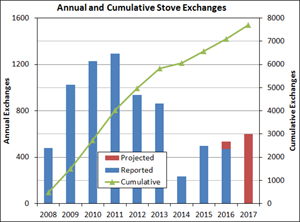Thursday, December 13 ~ BC.
Communities throughout the province are getting help to replace old, smoky woodstoves with cleaner technologies, so people do not have to choose between warm homes and cleaner air.
Woodstoves can create significant local air pollution, increasing particulate matter in the air. That pollution, also known as PM2.5, causes a variety of health problems, it was stated in a news release today from the Ministry of Environment and Climate Change Strategy.
That is why the Province has expanded its Provincial Wood Stove Exchange Program, which helps people trade old woodstoves for cleaner-burning models such as gas, propane, pellet-heating or — cleaner yet — electric models. This year, $300,000 is going to 15 BC communities — up from $200,000 in previous years.
“This worthwhile program shows we can tackle air pollution while making life more affordable,” says George Heyman, Minister of Environment and Climate Change Strategy. “It makes it easier for people to upgrade a central feature of their homes while staying warm and reducing carbon and other forms of pollution.”
Eligible British Columbians can apply for the following incentives:
- $250 for changing to a cleaner-burning wood stove; and
- $400 for changing to a qualifying electric heat pump, gas or propane stove, or pellet-fuelled stove.

To reduce pollution, there has to be efficient combustion, which is accomplished by maximizing the mixture of air and fuel. Air that is controlled by the user (with a valve or lever, for example) is called “primary air.” Bringing air to a fire in this manner isn’t very efficient, resulting in incomplete burns and combustible gasses going up the flue.
Most certified stoves bring air in through a thin opening above the firebox, making for a better mix of oxygen and fuel. Increased efficiency is accomplished during a second burning phase in which gasses are burned either by a catalytic combustor or a non-catalytic combustion system. This is what designates one stove type “catalytic” and another “non-catalytic.”
Since 2008, BC communities have received more than $3 million through the Provincial Wood Stove Exchange Program, helping replace almost 8,000 old stoves with cleaner-burning options. The program is administered by the British Columbia Lung Association, which also educates the public about alternatives to wood stoves.
“This program has helped remove tonnes of particulates from the air, while raising awareness about the dangers of burning wood,” said Christopher Lam, CEO, BC Lung Association. “People throughout the province now understand that wood smoke can cause harm.”
Fifteen of the communities that have been approved for funding are continuing their programs from previous years, with the qathet Regional District joining for the first time.
Cities or regions receiving funds this year include Alberni, Bulkley Valley, Comox Valley, Cowichan Valley, Fraser Valley, Golden, Kamloops, Metro Vancouver, Prince George and region, Kelowna and the central Okanagan, the Regional District of Central Kootenay, the Regional District of Nanaimo, Coldstream/Lumby, Powell River, the Sunshine Coast and Vanderhoof.
Funding for the 2017-18 wood stove exchange program:
* Alberni-Clayoquot Regional District: $20,650
* Bulkley Valley and Lakes District Airshed Management Society: $16,000
* Comox Valley Regional District: $35,400
* Cowichan Valley Regional District: $31,200
* Fraser Valley Regional District: $7,000
* Golden and District Air Quality Committee: $5,000
* City of Kamloops: $8,750
* Metro Vancouver Regional District: $56,000
* Prince George Air Improvement Roundtable: $10,500
* Central Okanagan Regional District: $9,500
* Regional District of Central Kootenay: $14,000
* Regional District of Nanaimo: $30,000
* Lavington Life Society: $5,000
* qathet Regional District: $14,500
* Sunshine Coast Clean Air Society: $13,500
* District of Vanderhoof: $3,750
In British Columbia, all new wood stoves and inserts sold must meet U.S. Environmental Protection Agency or Canadian Standards Association emission standards.
Always use dry, well-seasoned wood cut into pieces that are 10 to 15 centimetres in diameter. Burning ‘green’ or wet wood produces significantly more smoke.
Firewood should be seasoned for at least six months. Burning seasoned wood also saves money by reducing wood consumption by 25%.
By burning smaller, hotter fires to ensure complete combustion of the wood, there should be very little visible smoke coming from the chimney and no smell of smoke indoors.
Wood-burning appliances should be inspected and cleaned at least once a year by a certified technician.



